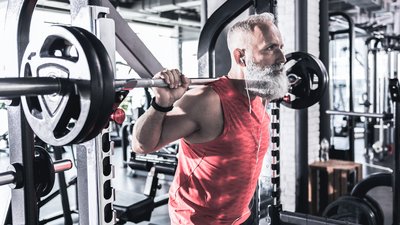Q: What's the best machine move for an older lifter?
Like any lifter, I have my favorite pieces of equipment that I find myself returning to over and over. But rather than risk picking a single machine that may or may not be in your gym, I'm going to slightly modify your original question to "What's the best category of machine moves?"
And the answer is this: Many older lifters would be well served to take better advantage of all manner of machine-based leg and quad exercises such as leg presses, hack squats, and yes, even Smith machine squats.
Here's why: Many lifters, and especially older lifters, have difficulty in safely training quads with squat variations due to their various orthopedic and/or mobility deficits. I fall into this category myself. After a couple of big knee surgeries in the 1980s, I was left with surgical scarring in my right knee which significantly limits my range of motion in that joint. That, combined with long femurs, and my squats look like this:
Now, there's nothing fundamentally unsound or unsafe about my squat technique. I'm maintaining a neutral lumbar spine, and my knees track directly over my feet. But when you lean forward as much as I do during squats, it's mostly a posterior chain movement. So, I continue to squat for my posterior chain, but I also make liberal use of leg presses, hack squats, Smith squats, and similar drills, because these exercises allow for much greater quad recruitment.
But these machines are also very useful for folks who can't, for whatever reason, maintain a neutral spine during squats. If you're one of those people, you'll find the leg press and other variations will allow you to stabilize your spine while training quads. And there's nothing wrong with that.
To be absolutely clear, though, this doesn't mean I give you permission to become one of those lifters who loads up the leg press (or any other machine) like a garbage truck, chases a 1-3-rep max, and only moves it a few inches at most. That kind of ego lifting doesn't help anyone, anywhere, and if you succumb to it, you're a lifting injury waiting to happen.
In my opinion, all of these machine-based squat alternates work best in slightly higher rep schemes, like a hard set of 10 at minimum. That's how I program them in my Bodybuilding.com BodyFit Elite program Total-Body Strong, and how you'll see the greatest benefit from them.
Don't Forget About Mobility!
Early in my response to this question, I said that many older lifters "have difficulty in safely training quads with squat variations due to various orthopedic and/or mobility deficits." When I recommend machines for these lifters, that doesn't mean you should ignore any orthopedic or mobility issues you have!
If your squat sucks because you have limited ankle dorsiflexion, you should definitely work to increase your ankle mobility. Similarly, if you can't manage to keep a neutral lumbar spine, I'd strongly recommend that you do whatever work might be necessary to solve that problem. If you simply have painful knees, hips, or back, again, start doing some research to figure out how to rehab them. John Rusin's articles are a great place to start.
Many folks view machine movements as inferior—and I used to be one them—probably because lifters so often use them as an unnecessary "shortcut" to lift heavier than they could with free weights. Of course, machines are a bad idea when you use them improperly, but that doesn't mean they're not worthwhile when used intelligently. So don't miss the forest for the trees. Improve your weaknesses, do what you can, and train hard with what you've got.

